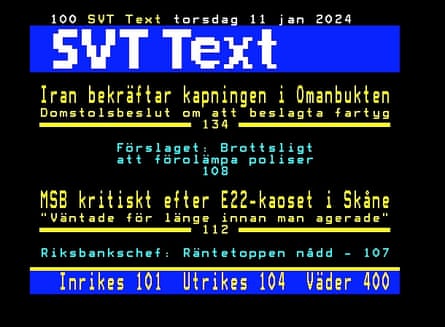A Swedish teletext employee has attributed the popularity of the world’s longest-running service of its kind to nostalgia and an appetite for trustworthy information, as it celebrates its 45th anniversary this year.
In most of the western world, teletext has been consigned to history by the advent of the internet and smartphones. But in Sweden, despite having one of the world’s most digitalised populations, SVT Text, run by the national public broadcaster, is still going strong, attracting 15% of the Swedish population aged nine to 85 on a daily basis.
According to Nordicom’s Media Barometer report, the figure is even higher among 65- to 85-year-olds, with 28% using it each day. For 15- to 24-year-olds the figure is 9%.
SVT’s two teletext desks are based in a news studio in the broadcaster’s building in Stockholm.
Erik Aldaeus, who has worked there since 2001, said the service remained popular because it provided “short, straightforward news – with no frills or fluff” and, in a landscape inundated with information, it was trusted.
“Swedes have always been at the forefront of technology, but they can also be nostalgic and like safety, not least in a changing world. This is where teletext fits in,” he said. “It looks the same as it always has done, it feels safe. Many want to live their lives as they always have done.”

Many older Swedes who live in digital isolation do not have access to the internet, he said, meaning teletext was their only form of online communication.
Although there have been some changes, such as the removal of teletext bingo, film reviews and stock exchange updates, much of it remains the same, providing continuity for its longtime users in a rapidly evolving, fast-paced world. The graphics remain similar to the 1979 original.
Unlike with the internet, it is not possible to monitor exactly what pages are the most popular, but content includes weather forecasts, TV guides, news and sport.
As well as its simple and concise format, SVT Text’s enduring appeal has been attributed to its lack of personality – articles are not bylined – and a format where the user is in control rather than being inundated by notifications.
after newsletter promotion
Aldaeus said SVT Text’s 45th anniversary on 12 March would be marked with a celebration of some sort.
He cannot imagine SVT following in the footsteps of the BBC and discontinuing the service, which he believes will remain for as long as people use it.
“I enjoy working with letters, words and wording. I also feel strongly for the largely older audience who are very loyal to teletext,” he said. “But everything has an end. Newspapers are on their way out, the phone book has already gone, who knows?”
